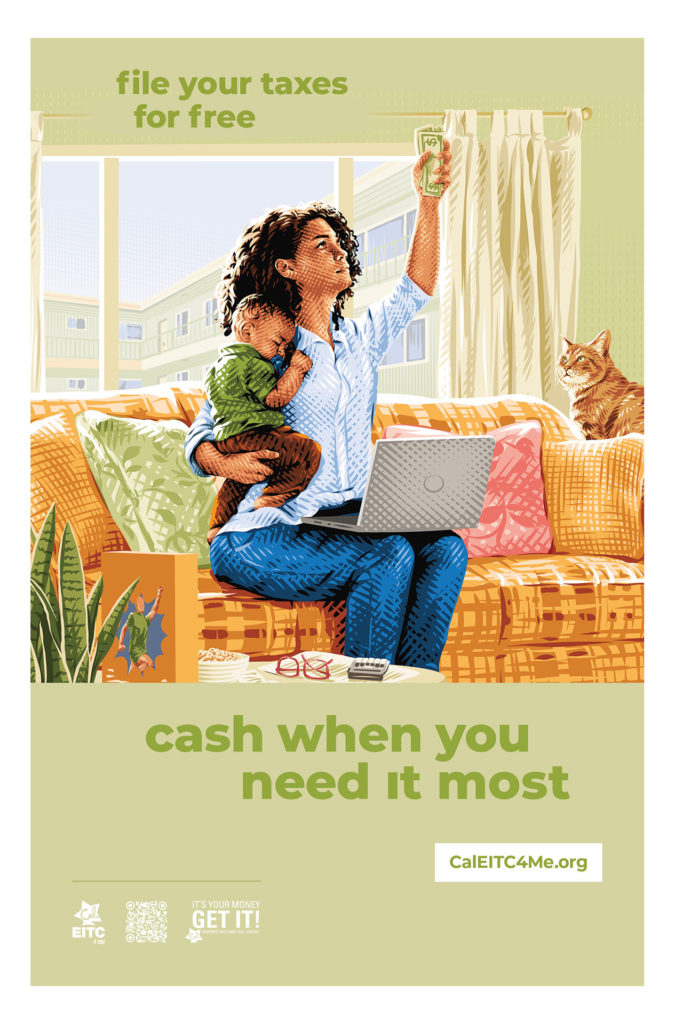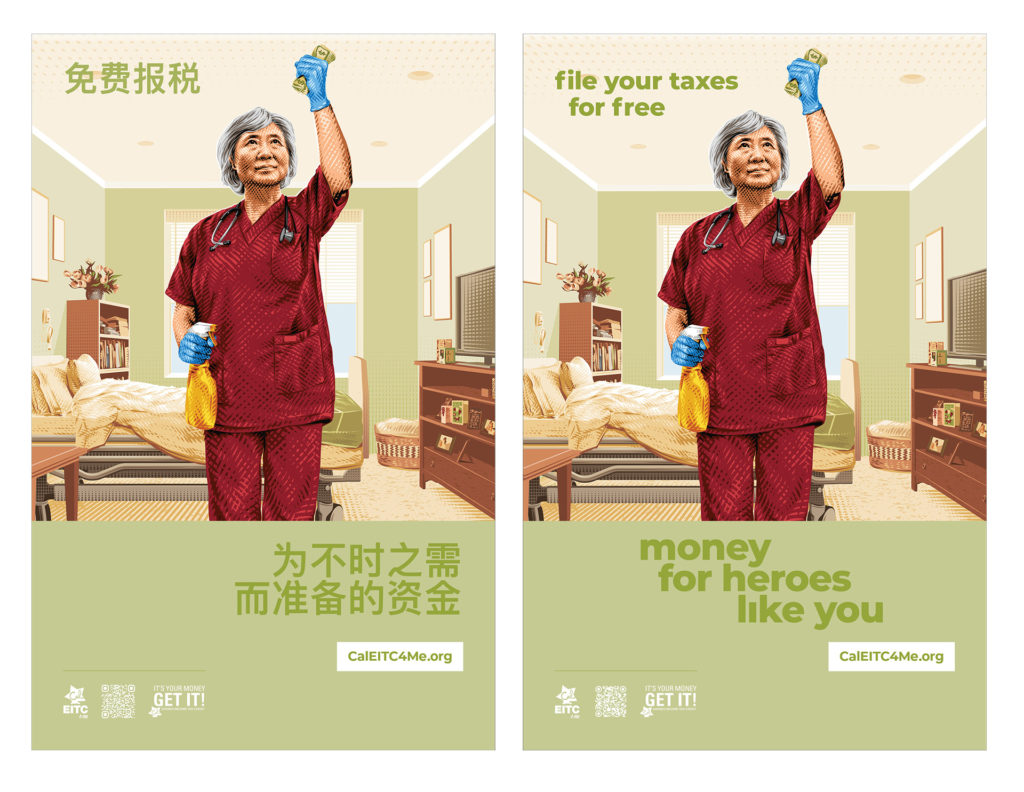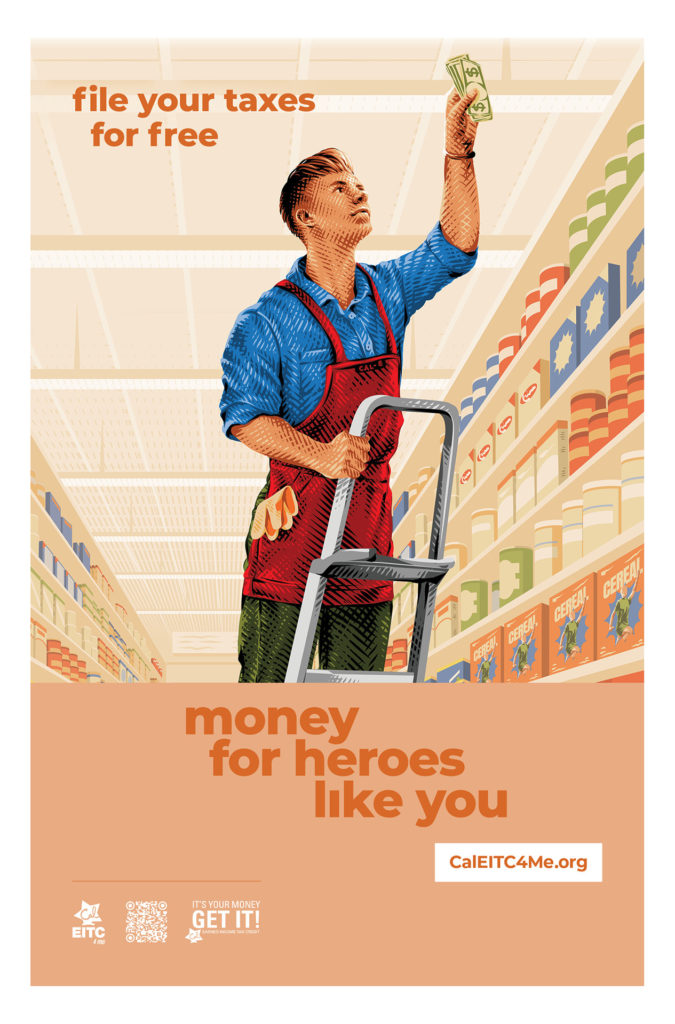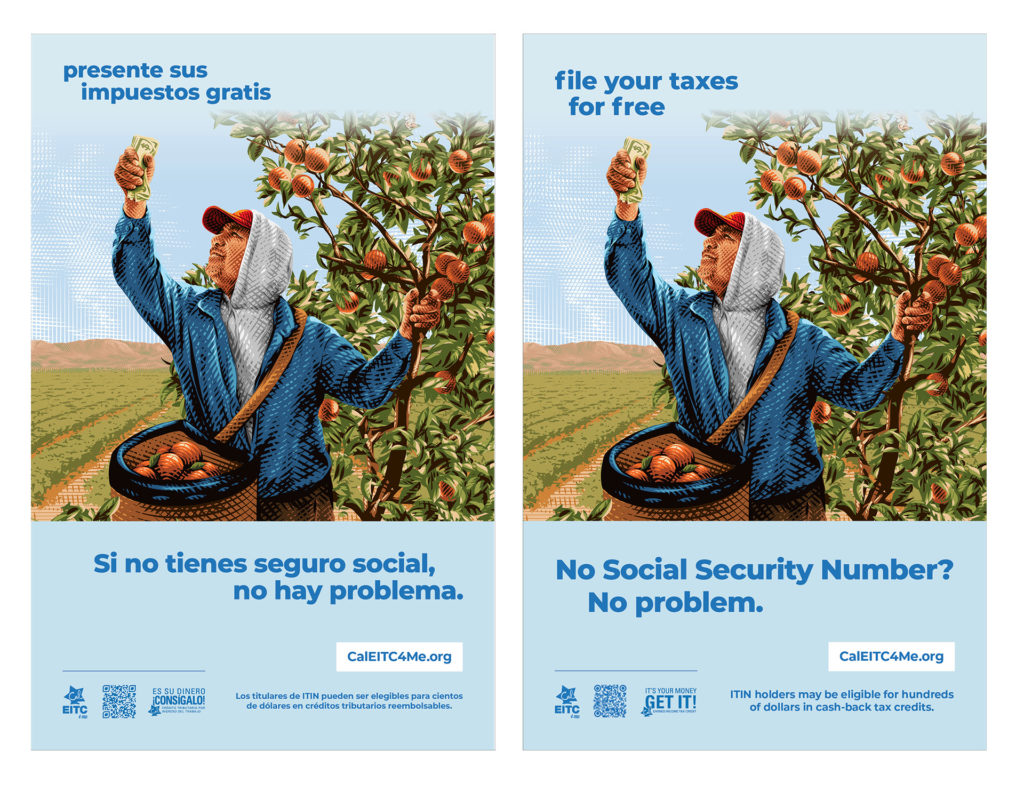Art Connects: An Interview with Tracie Ching
February 24, 2023
For Tracie Ching, art is much more than just putting color on a page. Art can be a movement builder, an inspiration, and even the spark that lights the fire of life changing decisions. And so, when Ching had the opportunity to create the artwork for CalEITC4Me’s latest campaign promoting the CalEITC and the Young Child Tax Credit–entitled Everyday Heroes–she leapt at the chance.
“For me, it’s about serving a larger purpose,” Ching said in a recent interview with CalEITC4Me. “I want my work to do some good while looking good doing it. And as a mixed race woman, I’ve seen firsthand how entire communities are underrepresented and underserved. And so to create artwork for a campaign with the potential to uplift and aid these communities, as well as in terms of again, that scope again, right, the people of California, there’s not much more I can ask for.”

Ching is well known for using her art as a way to uplift marginalized communities and support political causes she believes in. She created the official inaugural poster for President Joe Biden and Vice President Kamala Harris and her KavaNope poster protesting the appointment of Brett Kavanaugh to the US Supreme Court went viral. She has also supported voting initiatives with her art, including Michelle Obama’s When We All Vote and Amplifier’s Ride to the Polls Campaign.
She has also worked on PSAs for Smokey the Bear, the Equal Rights Amendment campaign and National Geographic’s Campaign for Nature.

However, she said that working on the Everyday Heroes campaign presented a rare opportunity for her to focus on everyday people, rather than well known faces and ideas.
“The most powerful work comes from its ability to connect, for people to relate to it,” she said. “And when people see the illustrations that I put together, I wanted them to be able to look at it and say, you know, that’s my friend, that’s my grandmother, that’s my uncle, you know, that’s me. And you know, their mom wore those scrubs, they had that couch or table growing up.  I want them to see that and to realize this opportunity is for them. As humans, we are incredibly visual creatures. And as such, art is one of the most effective means of communication, because art can move us. It can change us. That’s why it’s such a great marketing tool because we respond to it on this almost lizard brain level. And so for this campaign, I wanted the images to speak to the people we wanted to speak to, for it to stick in their brains and so that they remember to apply or someone that sees it remembers to tell someone that they know to apply.”
I want them to see that and to realize this opportunity is for them. As humans, we are incredibly visual creatures. And as such, art is one of the most effective means of communication, because art can move us. It can change us. That’s why it’s such a great marketing tool because we respond to it on this almost lizard brain level. And so for this campaign, I wanted the images to speak to the people we wanted to speak to, for it to stick in their brains and so that they remember to apply or someone that sees it remembers to tell someone that they know to apply.”

CalEITC4Me’s Everyday Heroes campaign kicked off last month and includes art highlighting the contributions of everyday heroes like moms, healthcare workers, essential workers, agriculture workers, and students. Read through Tracie’s entire interview below.
Learn more about CalEITC4Me as well as the CalEITC and Young Child Tax Credit at CalEITC4Me.org
View more of Tracie Ching’s artwork at TracieChing.com
Interview Transcript
CalEITC4Me: What made you interested in working with CalEITC4Me on our “Everyday Heroes” campaign?
Tracie Ching: My goal as an artist, unsurprisingly, is for the work to have impact, right? For me, it’s about serving a larger purpose. So I want my work to do some good while looking good doing it. And as a mixed race woman, I’ve seen firsthand how entire communities are underrepresented and underserved. And so to create artwork for a campaign with the potential to uplift and aid these communities, as well as in terms of scope–reaching the people of California– there’s not much more I can ask for with scope in mind. So this really aligns well.
CalEITC4Me: Was the name that we kind of came to you with, “the everyday heroes” theme, compelling to you and how did you approach illustrating to that theme?
TC: You know, there’s so much unprecedented Kismet with this campaign because you’ve seen my portfolio and you know I’ve spent a good part of my career illustrating internationally recognizable faces from movie stars to heads of state.
But this campaign gave me this really rare and deeply welcome opportunity to illustrate something more. Everyday people is not something I get asked to do often, for whatever reason, and it’s something I have felt a lack of in my career.
So it was just perfect. I thought: Yes, this is exactly what I want. I don’t want to draw X famous person, I want to draw your tía, your aunt.
The most powerful work comes from its ability to connect, for people to relate to it. And when people see the illustrations that I put together,I wanted them to be able to look at it and say, you know, that’s my friend, that’s my grandmother, that’s my uncle, you know, that’s me. I want them to see that and to realize this opportunity is for them.
We don’t want super clean stock photos, which is really common. We wanted this marketed to the everyday person or everyday hero, this exceptionalism. We just want these to look like normal people. And that was really important. And I hope that we balance those two things, between uplifting and marketing.
CalEITC4Me: You’ve touched on this a bit but how did you go about communicating the dignity of everyday heroes in low wage work through this campaign? Because, like you said, we don’t get those depictions often.
TC: And this kind of takes the point we were just talking about and brings it a bit further. So much of that messaging that we get is about who and what is of value, and not enough of it acknowledges the fact that, none of this works– not our food, not our healthcare, not our society, our country–works without the labor of these essential workers. And, you know, too often there’s this false narrative applied of expendability or pity or laziness around these individuals. So I really struggled to portray what I consider to be an undeniable truth, but people will try to deny it. The inherent strength and ingenuity, the love, the pride, the resilience of these workers. That approach, the effort they put in the work. I wanted to meet them there. I wanted to do the same and give loving attention to the details surrounding and embodying these people.
CalEITC4Me: It’s so exciting. Is there anything else you want to say about illustrating communities of color? Since we know that there are marginalized identities represented in our campaign intentionally?
TC: I felt capable of creating for this campaign. I always have to consider “am I the right person for this job? Can I do it? Am I the best person?” If I’m not, I’ll point you in the direction of someone I think might be able to handle it better. I felt that I could create for this campaign because of my personal experience of being a mixed race kid raised by a single mother growing up.
I spent multiple times throughout my childhood as well as young adulthood in low income neighborhoods. Now, that being said, I can’t speak directly to the experiences of like, all generations and all communities of color, right? And so when it comes to trying to approach jobs like this, I could never know that struggle. I just try to portray everyone with equality and fidelity because everyone has their own preferences in terms of manner and language and aesthetics. But I think it all really just breaks down that we all want to be represented and spoken about in the same way, which is with respect, and you’ve touched on that already.
So if we’re just trying to come from the most accurate perspective, I have to educate myself quite a bit. I’m going to make mistakes and be wrong. And I also need to be aware that I can have my predispositions and inbred biases. And then also the real privilege that I’ve gotten over the last couple of years to be able to sit in a space and say hey, that doesn’t seem right. It’s really just coming from that point of just respect, understanding and openness when we talk about anyone.
CalEITC4Me: We were all really inspired by the Ride to the Polls campaign you illustrated for so we were just wondering if you could tell us about any other standout issues or campaigns or social justice organizations that you worked with.
TC: I’ve had a really long standing history with social justice initiatives as a whole. I had a poster go viral during the protests against the Cavanaugh confirmation. In 2019, I was part of the design team that designed much of the aesthetic around the Women’s March. I’ve worked on a lot of voting campaigns and initiatives for Amplifier, which Ride to the Polls was one the most recent.
I’ve also worked on Michelle Obama’s When We All Vote and I’ve also had the pleasure of working with Nia Tero on indigenous stewardship and sovereignty, especially tied to climate change. And then really recently I worked on artwork for the Smokey the Bear PSAs and also for the Equal Rights Amendment campaign to have that ratified and added to our constitution.
CalEITC4Me: How does the Everyday Heroes campaign align with your past projects and your greater body of work? How does it fit into everything else you’ve done? In your view?
TC: Yeah, as I’ve mentioned, it’s about the greater good angle, right? My hope has always been that my unique skill set is used to benefit the greater good. That’s ultimately what I would love to be associated with. And it may sound like an egotistical read that I want my work to benefit the greater good, but changing the trajectory of someone’s day is easier than we think. And it creates a cascade that could change their entire lives. And I think people forget, it just takes a little push, it just takes a little nudge.
And as humans, we are incredibly visual creatures. And as such, art is one of the most effective means of communication, because art can move us. It can change us. That’s why it’s such a great marketing tool because we respond to it on this almost lizard brain level. And so for this campaign, I wanted the images to speak to the people we wanted to speak to, for it to stick in their brains and so that they remember to apply or someone that sees it remembers to tell someone that they know to apply. And that serves my overarching goal. Because, again, I firmly believe, I don’t feel like it’s up for debate, that social programs are integral to the betterment of society, period. They have a profound impact. And I want to build toward that. And my way of doing that is line by line, poster by poster.